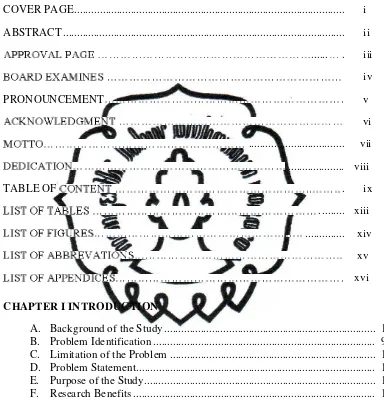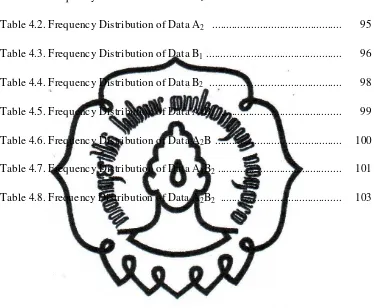commit to user
i
THE EFFECTIVENESS OF PROJECT-BASED LEARNING
TO TEACH SPEAKING VIEWED FROM
S
(An Experimental Study at the Seventh Grade Students of
SMPK Santo Yusuf Madiun in the 2012/2013 Academic Year)
Thesis
By:
LUSIA ENDERIA REJEKI
NIM. S891108061
ENGLISH EDUCATION DEPARTMENT
GRADUATE SCHOOL
commit to user
ii
ABSTRACT
Lusia Enderia Rejeki. S891108061. The Effectiveness of Project-Based
Learning to Teach Speaking Viewed f Creativity (An Experimental
Research at Seventhh Grade of SMPK Santo Yusuf Madiun in the Academic Year of 2012/2013). The first Consultant: Dra. Dewi Rochsantiningsih, M.Ed., Ph.D., The second Consultant: Dr. Ngadiso, M.Pd. Thesis. Surakarta. English Education Department, Graduate School of Sebelas Maret University, Surakarta. 2013.
The objectives of this research are: (1) to find out whether Project-Based Learning is more effective than Direct Method to teach speaking to the seventh grade students of SMPK Santo Yusuf in the academic year of 2012/2013; (2) to find out whether the students having high creativity have better speaking skill than those having low creativity; and (3) to find out whether there is an interaction between teaching methods and creativity in teaching speaking to the seventh grade students of SMPK Santo Yusuf in the academic year of 2012/2013.
The research method was an experimental study. The research was conducted in SMPK Santo Yusuf Madiun. The population was the seventh grade students of SMPK Santo Yusuf Madiun in the academic year of 2012/2013. The researcher used cluster random sampling to get the sample. There were two classes used as sample. One class consisted of 22 students who were experimental class taught by Project-Based Learning and the other 22 students were as control class taught by Direct Method. The instruments of collecting data are speaking
test and . The data were
analyzed by using multifactor analysis of variance 2x2. Then, it was analyzed by using Tukey test.
Based on the research findings, in general it can be concluded that Project-Based Learning is an effective method to teach speaking. Therefore, the teacher is suggested to apply Project-Based Learning for teaching speaking.
commit to user
commit to user
commit to user
commit to user
ACKNOWLEDGEMENT
The biggest gratitude in this life is devoted to Jesus Christ and Holy Mary for all of lovely gifts. This blessing is becoming a step closer to the real dreams.
Moreover, it is necessary to pray and devote this thesis to every people consultant who have given their valuable advice, guidance, correction, and suggestion for the completion of this thesis.
3. The Principal of SMPK Santo Yusuf Madiun, Drs. C. Paulus Suban M., Drs. Handri Raharjo and Br. Aleksander Kadiyono, CSA. M.Pd. who has given permission to conduct the research.
4. The English teacher for his advice, guidance, and cooperation during the
research.
5. All of the students of the seventh grade of SMPK Santo Yusuf Madiun in the
academic year of 2011/2012, especially for, VII-A and VII-B, for their cooperation during the research.
6. The beloved father and mother for their caring, praying, and love; beloved
brothers for their support; beloved friend one who gives a lot of information, support, and understanding; and also beloved special one for understanding, patient, and love.
7. All the classmates in D class.
Finally, the writer realizes that this thesis is still far from being perfect. Therefore, the writer accepts the correction and suggestion to improve the quality
of this thesis.
Surakarta, May 2014
commit to user
vii
MOTTO
Love is the flower of life, and blossoms unexpectedly and without
law, and must be plucked where it is found, and enjoyed for the brief
hour of its duration.
-commit to user
viii
DEDICATION
This thesis is dedicated to:
My beloved father and mother, who always love me
unconditionally.
My beloved brothers who always encourage and
support me.
My beloved special one for every passion,
understanding, and be my side no matter what.
My boy acquaintance for answering my prayer, you
commit to user
CHAPTER II REVIEW OF RELATED LITERATURE A. Speaking ... 13
7. The Problems with Speaking Activity ... 23
8. The Ideas of Solving Problems in Speaking Activity ... 25
commit to user
x
10. Speaking Assessment ... 28
11. Construct of Speaking ... 32
B. The Method of Teaching Speaking ... 32
1. The Project-Based Learning (PBL) a. Concept of Project-Based Learning ... 34
b. Teaching Steps of PBL ... 38
c. Advantages and Disadvantages of PBL ... 41
d. Construct of PBL ... 43
2. The Direct Method a. Concept of DM ... 43
b. Teaching Steps of DM ... 45
c. Advantages and Disadvantages of DM ... 47
d. Construct of DM ... 49
C. Teaching Speaking Using PBL compared to Direct Method ... 49
D. Creativity 1. Definition of Creativity ... 51
2. Concept of Creativity in Teaching Speaking ... 54
3. Measuring Creativity ... 57
4. Construct of Creativity ... 61
E. Review of Related Theories ... 62
F. Rationale ... 71
G. Hypothesis ... 76
CHAPTER III CONTEXT OF THE RESEARCH A. Setting, Time of the Research, and Profile of the Speaking Class ... 77
B. Research Method ... 78
C. Population, Sample, and Sampling ... 79
D. Data Collecting Technique ... 80
E. Technique of Analyzing Data ... 84
CHAPTER IV THE RESULT OF THE STUDY A. Implication of Study ... 92
B. The Description of the Data ... 93
1. The Data of Speaking Test of Experiment Class Taught Using Project-Based Learning (A1) ... 94
2. The Data of Speaking Test of Experiment Class Taught Using Direct Method (A2) ... 95
3. The Data of Speaking Test of the Students Having High Creativity (B1) ... 96
4. The Data of Speaking Test of the Students Having Low Creativity (B2) ... 97
commit to user
xi
6. The Data of Speaking Test of the Students Having High Creativity
Taught Using Direct Method (A1B1)... 100
7. The Data of Speaking Test of the Students Having Low Creativity Taught Using Project-Based Learning (A1B2) ... 101
8. The Data of Speaking Test of the Students Having Low Creativity Taught Using Direct Method (A2B2)... 102
C. Normality and Homogeneity Test ... 103
1. Normality Test ... 104
2. Homogeneity Test ... 104
D. Hypothesis Test ... 106
1. Summary of ANOVA Test ... 106
2. Summary of 2x2 Multifactor of Variance ... 107
3. Summary of Tukey Test ... 108
E. Discussion 1. Using Project-Based Learning is More Effective than Direct Method ... 110
2. The Students Who Have High Creativity Have Better Speaking Skill than the Students Who Have Low Creativity) ... 112
3. There is Creativity in Teaching Speaking ... 114
CHAPTER V CONCLUSSION, IMPLICATION, AND SUGGESTION A. Conclusion ... 117
B. Implication ... 118
C. Suggestion ... 119
commit to user
xii
LIST OF TABLES
Table 3.1. Time schedule of the research ... 77
Table 3.2. 2x2 Factorial Design ... 79
Table 3.3. Analytic Scoring Rubric for Speaking Criteria ... 82
Table 3.4. The Blue Print of Verbal Creativity Test ... 84
Table 3.4. The Design of Multifactor Analysis of Variance ... 86
Table 4.1. Frequency Distribution of Data A1 ... 95
Table 4.2. Frequency Distribution of Data A2 ... 95
Table 4.3. Frequency Distribution of Data B1 ... 96
Table 4.4. Frequency Distribution of Data B2 ... 98
Table 4.5. Frequency Distribution of Data A1B1 ... 99
Table 4.6. Frequency Distribution of Data A2B ... 100
Table 4.7. Frequency Distribution of Data A1B2 ... 101
Table 4.8. Frequency Distribution of Data A2B2 ... 103
Table 4.9. Normality Test ... 104
Table 4.10. Homogeneity Test ... 105
Table 4.11. Summary of Multifactor Analysis of Variance ... 106
Table 4.12. Summary of 2x2 Multifactor Analysis of Variance ... 107
commit to user
xiii
LIST OF FIGURES
Table 4.1. Frequency Distribution of Data A1 ... 95
Table 4.2. Frequency Distribution of Data A2 ... 95
Table 4.3. Frequency Distribution of Data B1 ... 96
Table 4.4. Frequency Distribution of Data B2 ... 98
Table 4.5. Frequency Distribution of Data A1B1 ... 99
Table 4.6. Frequency Distribution of Data A2B ... 100
Table 4.7. Frequency Distribution of Data A1B2 ... 101
commit to user
xiv
LIST OF APPENDICES
Appendix 1. Lesson Plan of Experimental Class ... 122
Appendix 2. Lesson Plan of Control Class ... 231
Appendix 3. Instrument of Verbal Creativity (try out) ... 333
Appendix 4. Instrument of Verbal Creativity (after try out) ... 337
Appendix 5. Scoring Rubric of Speaking ... 341
Appendix 6. Blue Print of Speaking ... 342
Appendix 7. Scoring Rubric of Verbal Creativity ... 345
Appendix 8. Blue Print of Verbal Creativity ... 346
Appendix 9. Readability of Speaking Test ... 347
Appendix 10. Tabulation of Creativity and Speaking Score Taught by Project-Based Learning ... 350
Appendix 11. Tabulation of Creativity and Speaking Score Taught by Direct Method ... 351
Appendix 12. Descriptive Analysis... 352
Appendix 13. Normality ... 371
Appendix 14.Data Homogeneity ... 383
Appendix 15. ANOVA ... 388
Appendix 16. Tukey Test ... 389

